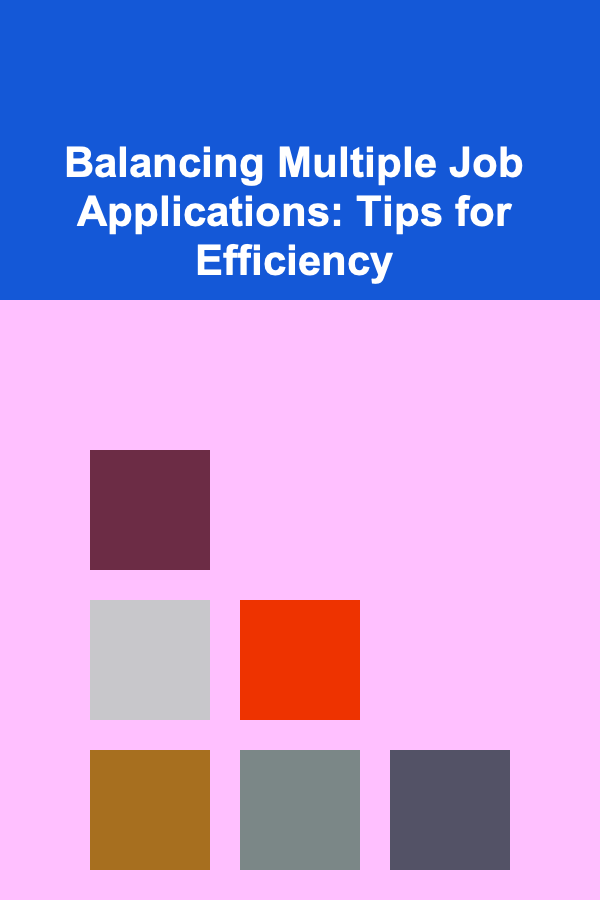
Balancing Multiple Job Applications: Tips for Efficiency
ebook include PDF & Audio bundle (Micro Guide)
$12.99$6.99
Limited Time Offer! Order within the next:

Job hunting is a significant part of any career journey, but when you're juggling multiple job applications simultaneously, it can feel overwhelming. The process of tailoring resumes, writing cover letters, preparing for interviews, and keeping track of deadlines requires focus, organization, and time management. If you find yourself submitting numerous applications in pursuit of the perfect opportunity, you need an effective strategy to ensure you're not only productive but also efficient. This actionable guide will provide you with the necessary tips and techniques to balance multiple job applications and optimize your efforts throughout the process.
Set Clear Goals for Your Job Search
Before diving into the actual applications, it's essential to set clear and realistic goals. Understanding your objectives will provide you with a sense of direction, and it will help you manage your time and energy effectively.
Define Your Job Search Criteria
Start by narrowing down the types of jobs that interest you. Be specific about your desired role, industry, and location. For example, if you're looking for a marketing position, you could specify roles like Digital Marketing Manager, Content Strategist, or Social Media Coordinator. Identifying these roles will not only guide your application process but also streamline the time you spend researching job openings.
Set Realistic Targets
When you're applying for multiple positions, it's easy to fall into the trap of applying to every opportunity that seems even remotely relevant. Instead, aim to apply to a manageable number of roles each week. For example, setting a target of applying to 5-10 roles per week ensures that you're staying consistent without spreading yourself too thin. With this target in mind, you can avoid burnout and maintain high-quality applications.
Create a Job Application Tracker
Managing several job applications at once without getting confused or missing deadlines requires careful organization. One of the best ways to do this is by creating a job application tracker.
Why Use a Tracker?
A tracker helps you stay on top of:
- Application Deadlines: Knowing when to submit applications and follow up is crucial to not missing opportunities.
- Application Status: You can track whether you've already applied to a position, are waiting for an interview, or have been rejected.
- Company Details: With multiple applications, it's easy to forget which company you're applying to and what specific role they offered. Your tracker will record these details.
How to Set Up a Job Tracker
You can create a simple tracker using tools like Google Sheets or Excel. Here's a basic structure for your tracker:
| Company Name | Job Title | Application Date | Deadline | Status | Follow-Up Date | Notes | |------------------|-------------------|----------------------|--------------|-------------------|--------------------|---------------------------| | Company A | Marketing Manager | 2025-04-10 | 2025-04-15 | Applied | 2025-04-20 | Tailored resume | | Company B | Graphic Designer | 2025-04-12 | 2025-04-18 | Interviewed | 2025-04-19 | Phone interview scheduled | | Company C | Software Engineer | 2025-04-13 | 2025-04-17 | Awaiting Response | 2025-04-21 | Applied via LinkedIn |
This system allows you to maintain an overview of all your applications, deadlines, statuses, and necessary follow-up actions in one place.
Tailor Your Application Materials
One of the most time-consuming aspects of applying for jobs is customizing your resume and cover letter for each role. However, to increase your chances of standing out, you must put in the effort to tailor your materials for each application. Doing this efficiently requires strategic thinking and organization.
Build a Strong Resume Template
Instead of starting from scratch every time, create a strong base resume template that you can quickly modify based on the specific role you're applying for. Ensure that your template includes:
- Core Skills: A list of your key strengths, which can be tailored according to job descriptions.
- Work Experience: Make sure this section can be adjusted to highlight the most relevant experience for each job.
- Achievements and Results: Have quantifiable results ready to be inserted where applicable.
Write a Versatile Cover Letter Template
Similarly, have a general cover letter template, but customize it to each company and role. A good structure for your cover letter might include:
- Introduction: Briefly introduce yourself and explain why you're interested in the specific role and company.
- Why You're a Fit: Highlight how your skills and experience align with the role and the company's needs.
- Your Enthusiasm: Show your excitement for the opportunity and explain why you're drawn to the company's values, mission, or work.
- Closing Statement: Conclude with a strong, polite call to action, such as expressing interest in scheduling an interview.
Save Time Using Templates
When writing these materials, always save a copy of each tailored resume and cover letter. Create folders for each application so you can easily access and send the right documents when needed.
Streamline Your Job Search Process
Efficiency in job hunting is about more than just tracking applications. To stay on top of multiple applications, you need to manage your time effectively and keep your research focused.
Use Job Alerts
Many job boards and company career pages allow you to set up email alerts for relevant job postings. This ensures that you receive notifications about new opportunities and helps you stay proactive in applying.
Dedicate Time Blocks for Job Search
Time blocking is a productivity strategy where you dedicate specific periods to focused tasks. For job applications, block out 1-2 hours each day to research jobs, tailor your resume/cover letter, and apply. Stick to your schedule to avoid getting distracted or overwhelmed by other responsibilities.
Organize Your Research
When you come across a job opening, be sure to note down key information (such as company name, job title, job description, and application instructions) in your tracker right away. This way, you won't have to revisit the job listing multiple times, saving time and effort in the long run.
Stay Organized and On Top of Deadlines
A key component of balancing multiple job applications is keeping track of deadlines and managing follow-ups. With a large number of applications, it's easy to lose track of when you need to follow up or when a new opportunity closes.
Set Reminders for Deadlines
Use digital tools like Google Calendar or task management apps (e.g., Todoist, Trello) to set reminders for each application's deadline. This ensures you submit applications on time and follow up as needed.
Automate Follow-Up Emails
Once you've submitted an application or completed an interview, it's essential to follow up. Set a reminder in your tracker to follow up if you haven't heard back after a set period. Having a template for follow-up emails will save you time and make the process smoother.
Manage Interview Schedules
If you land multiple interviews, use a calendar app to schedule them and set reminders. This helps you avoid overlap and ensures that you're fully prepared for each interview.
Take Care of Yourself
While staying organized and efficient is critical during your job search, it's equally important to maintain a healthy work-life balance. The job hunt can be emotionally draining, and overloading yourself with too many applications can lead to burnout.
Pace Yourself
Don't try to apply to dozens of jobs every day. Instead, aim for a steady pace that is sustainable over the long term. Taking breaks between applications will help you stay energized and focused.
Manage Stress
Job searching can be stressful, so it's important to make time for self-care. Whether it's exercising, spending time with loved ones, or engaging in a hobby, don't forget to take time for activities that recharge your mental and emotional batteries.
Conclusion
Balancing multiple job applications requires a combination of organization, time management, and strategic planning. By setting clear goals, creating a tracker, tailoring your materials efficiently, and staying organized, you can maintain control over the application process. Additionally, taking care of your well-being ensures that you can continue to put your best foot forward in each application.
With the right approach, the process of applying to multiple jobs doesn't have to be chaotic or overwhelming. Instead, it can be an efficient and rewarding experience that brings you closer to your next career opportunity.
Reading More From Our Other Websites
- [Home Staging 101] How to Create an Inviting Dining Room That Appeals to Buyers
- [Gardening 101] From Yard to Table: Designing an Edible Landscape for Every Season
- [Polymer Clay Modeling Tip 101] How to Produce Polymer Clay Replicas of Classic Film Props for Movie Buffs
- [Screen Printing Tip 101] Best Approaches to Achieve Consistent Ink Opacity Across Different Fabric Types
- [Metal Stamping Tip 101] Cost‑Effective Strategies for Reducing Waste in Metal Stamping Operations
- [Home Space Saving 101] How to Maximize Small Kitchen Storage with Pantry Organization Tips
- [Organization Tip 101] How to Use Virtual Collaboration Tools to Enhance Productivity
- [Personal Investment 101] How to Invest in Cryptocurrencies Safely
- [Home Renovating 101] How to Transform Your Home's Garage into a Useful Space
- [Personal Finance Management 101] How to Master Financial Literacy for Young Adults Before You Turn 30

How to Create a Consistent Brand Voice Across All Your Content
Read More
How to Create a Family Yoga Routine at Home
Read More
How to Sell Rare Coins on Online Numismatic Marketplaces: A Comprehensive Guide
Read More
How to Store Essential Oils in a Cool, Dry Place
Read More
10 Tips for Organizing a Wildlife Rescue Transport
Read More
10 Tips for Designing a Minimalist Website That Converts
Read MoreOther Products

How to Create a Consistent Brand Voice Across All Your Content
Read More
How to Create a Family Yoga Routine at Home
Read More
How to Sell Rare Coins on Online Numismatic Marketplaces: A Comprehensive Guide
Read More
How to Store Essential Oils in a Cool, Dry Place
Read More
10 Tips for Organizing a Wildlife Rescue Transport
Read More